
Diplacus rupicola, the Death Valley monkeyflower, is a flowering plant in the family Phrymaceae.

Erythranthe cardinalis, the scarlet monkeyflower, is a flowering perennial in the family Phrymaceae. Together with other species in Mimulus section Erythranthe, it serves as a model system for studying pollinator-based reproductive isolation. It was formerly known as Mimulus cardinalis.

Erythranthe nudata, the bare monkeyflower, is a species of monkeyflower endemic to the serpentine soils of Colusa, Lake and Napa Counties in California. It is an annual flower with bright yellow tube-shaped blooms and small narrow leaves.
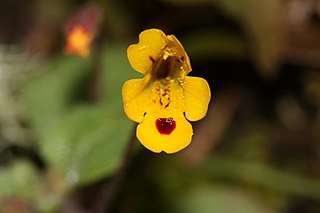
Erythranthe alsinoides is a species of monkeyflower known by the common names wingstem monkeyflower and chickweed monkeyflower. It was formerly known as Mimulus alsinoides.

Erythranthe androsacea is a species of monkeyflower known by the common name rockjasmine monkeyflower. It was formerly known as Mimulus androsaceus.

Diplacus angustatus is a species of monkeyflower known by the common names purplelip pansy monkeyflower and narrowleaf pansy monkeyflower.

Diplacus bigelovii is a species of monkeyflower known by the common name Bigelow's monkeyflower. It is native to the southwestern United States, where it grows in desert and slope habitats. It was formerly known as Mimulus bigelovii.
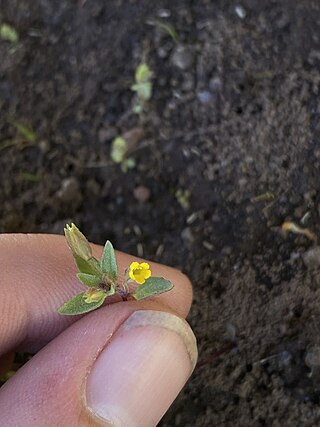
Erythranthe breviflora is a species of monkeyflower known by the common name shortflower monkeyflower. It is native to western North America from British Columbia to Wyoming to the Modoc Plateau and northern Sierra Nevada in California. It grows in moist areas in several types of habitat. It was formerly known as Mimulus breviflorus.
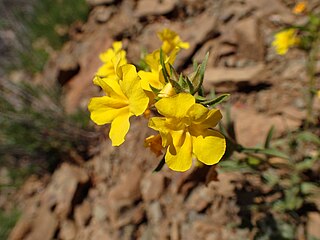
Diplacus brevipes is a species of monkeyflower known by the common name widethroat yellow monkeyflower. It was formerly known as Mimulus brevipes.
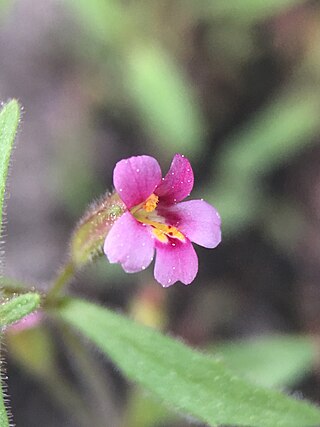
Erythranthe breweri is a species of monkeyflower known by the common name Brewer's monkeyflower. It is native to western North America from British Columbia to California to Colorado, where it grows in moist spots in several habitat types. This is a hairy annual herb producing a thin, erect stem up to 21 centimeters tall. The herbage is reddish green in color. The paired opposite leaves are linear in shape and up to 3.5 centimeters long. The plant bears small tubular flowers, each with its base encapsulated in a lightly hairy calyx of sepals with tiny equal lobes at its mouth. The five-lobed flower corolla is just a few millimeters long and light purplish pink in color, often with darker spots in the throat. It was formerly known as Mimulus breweri.

Diplacus clevelandii is an uncommon species of monkeyflower known by the common name Cleveland's bush monkeyflower. It was formerly known as Mimulus clevelandii.
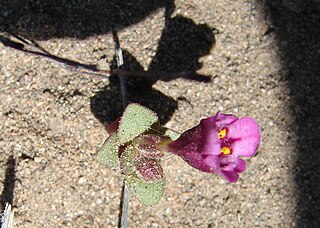
Diplacus cusickii is a species of monkeyflower known by the common name Cusick's monkeyflower. It is native to the western United States, where it can be found in parts of the Pacific Northwest and Great Basin. It grows in moist spots in bare and scrubby habitat, rocky slopes and plateau.
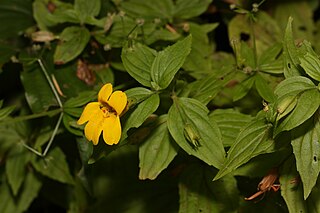
Erythranthe dentata is a species of monkeyflower known by the common names coastal monkeyflower and toothleaf monkeyflower. It is native to the western coast of North America from British Columbia to northern California, where it grows in moist habitat. It was formerly known as Mimulus dentatus.

Erythranthe filicaulis, known by the common name slender-stemmed monkeyflower, is a species of monkeyflower. It was formerly known as Mimulus filicaulis.
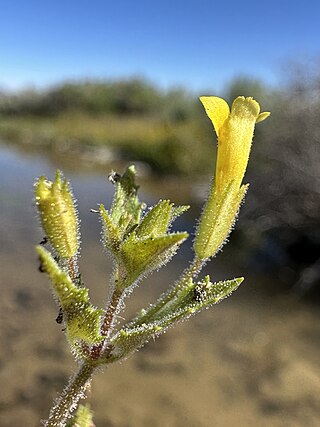
Erythranthe floribunda is a species of monkeyflower known by the common name many-flowered monkeyflower. It is native to western North America from western Canada to California and northern Mexico, to the Rocky Mountains. It grows in many types of habitat, especially moist areas. It was formerly known as Mimulus floribundus.
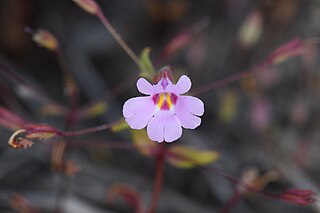
Erythranthe gracilipes is an uncommon species of monkeyflower known by the common name slenderstalk monkeyflower. It was formerly known as Mimulus gracilipes.
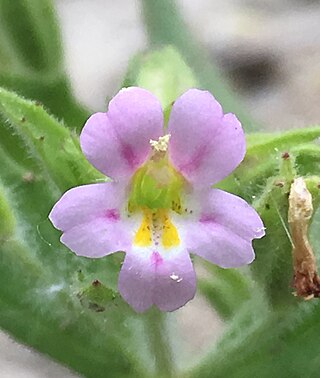
Erythranthe parishii is a species of monkeyflower known by the common name Parish's monkeyflower. It was formerly known as Mimulus parishii.

Erythranthe shevockii is a rare species of monkeyflower known by the common name Kelso Creek monkeyflower. It was formerly known as Mimulus shevockii.

Diplacus whitneyi is a species of monkeyflower known by the common name Harlequin monkeyflower. It was formerly known as Mimulus lewisii. It is also known as Diplacus bicolor.

Erythranthe suksdorfii, with the common names Suksdorf's monkeyflower and miniature monkeyflower, is an annual flowering plant in the family Phrymaceae (Lopseed). It was formerly known as Mimulus suksdorfii. A specimen collected in Washington state in 1885 by the self-taught immigrant botanist Wilhelm Nikolaus Suksdorf was identified as a new species by Asa Gray in 1886, who named it in Suksdorf's honor. It can easily be misidentified with Erythranthe breviflora, which generally has elliptic leaves rather than the linear or oblong leaves found in E. suksdorfii.




















